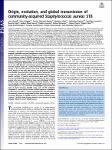Origin, evolution, and global transmission of community-acquired Staphylococcus aureus ST8
Strauß, Lena
Stegger, Marc
Akpaka, Patrick Eberechi
Alabi, Abraham
Breurec, Sebastien
Coombs, Geoffrey
Egyir, Beverly
Larsen, Anders Rhod
Laurent, Frederic
Monecke, Stefan
Peters, Georg
Skov, Robert
Strommenger, Birgit
Vandenesch, François
Schaumburg, Frieder
Mellmann, Alexander
USA300 is a pandemic clonal lineage of hypervirulent, community-acquired, methicillin-resistant Staphylococcus aureus (CA-MRSA) with specific molecular characteristics. Despite its high clinical relevance, the evolutionary origin of USA300 remained unclear. We used comparative genomics of 224 temporal and spatial diverse S. aureus isolates of multilocus sequence type (ST) 8 to reconstruct the molecular evolution and global dissemination of ST8, including USA300. Analyses of core SNP diversity and accessory genome variations showed that the ancestor of all ST8 S. aureus most likely emerged in Central Europe in the mid-19th century. From here, ST8 was exported to North America in the early 20th century and progressively acquired the USA300 characteristics Panton–Valentine leukocidin (PVL), SCCmec IVa, the arginine catabolic mobile element (ACME), and a specific mutation in capsular polysaccharide gene cap5E. Although the PVL-encoding phage ϕSa2USA was introduced into the ST8 background only once, various SCCmec types were introduced to ST8 at different times and places. Starting from North America, USA300 spread globally, including Africa. African USA300 isolates have aberrant spa-types (t112, t121) and form a monophyletic group within the clade of North American USA300. Large parts of ST8 methicillin-susceptible S. aureus (MSSA) isolated in Africa represent a symplesiomorphic group of ST8 (i.e., a group representing the characteristics of the ancestor), which are rarely found in other world regions. Isolates previously discussed as USA300 ancestors, including USA500 and a “historic” CA-MRSA from Western Australia, were shown to be only distantly related to recent USA300 clones.
Dateien zu dieser Publikation
Keine Lizenzangabe

